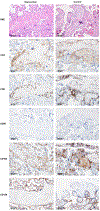Fetal surgery is not associated with increased inflammatory placental pathology
- PMID: 36688485
- PMCID: PMC10132489
- DOI: 10.1002/pd.6319
Fetal surgery is not associated with increased inflammatory placental pathology
Abstract
Objective: Fetal surgery has improved neonatal outcomes; however, it is unknown if the intervention contributes to the developmental of inflammatory pathologies in the placenta. Here, an association between fetal surgery and placental pathology was examined.
Method: This case-control study compared pregnancies with fetal surgery (n = 22), pregnancies with an indication for fetal surgery but without an intervention being done (n = 13), and gestational-age and fetus-number matched controls (n = 36). Data on maternal, infant, and placental outcomes were abstracted. Additionally, immunohistochemistry identified expression of lymphoid and myeloid cells in the placenta on a subset of cases. Comparisons were performed using Kruskal-Wallis or Pearson's chi-squared tests.
Results: Maternal characteristics were comparable between groups. Most fetal interventions were for diaphragmatic hernia, spina bifida, or twin-to-twin transfusion syndrome. Fetuses who were operated on before birth were more likely to be born preterm (p = 0.02). There was no increase in the rate of observed placental pathologies or immune cell infiltration in fetal surgery cases compared to controls.
Conclusion: The data suggest that fetal surgery is not associated with increased inflammatory or morphologic pathology in the placenta. This observation supports the growing field of fetal surgery.
© 2023 John Wiley & Sons Ltd.
Conflict of interest statement
Figures




References
-
- Senat MV, Deprest J, Boulvain M, Paupe A, Winer N, Ville Y. Endoscopic laser surgery versus serial amnioreduction for severe twin-to-twin transfusion syndrome. N Engl J Med. 2004;351(2):136–144. - PubMed
-
- Ruano R, Klinkner DB, Balakrishnan K, et al. Fetoscopic Therapy for Severe Pulmonary Hypoplasia in Congenital Diaphragmatic Hernia: A First in Prenatal Regenerative Medicine at Mayo Clinic. Mayo Clin Proc. 2018;93(6):693–700. - PubMed
-
- Van Calster B, Benachi A, Nicolaides KH, et al. The randomized Tracheal Occlusion To Accelerate Lung growth (TOTAL)-trials on fetal surgery for congenital diaphragmatic hernia: reanalysis using pooled data. Am J Obstet Gynecol. 2022;226(4):560.e561–560.e524. - PubMed
MeSH terms
Grants and funding
LinkOut - more resources
Full Text Sources

